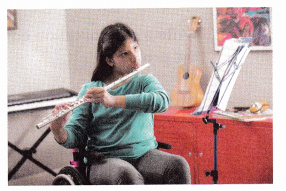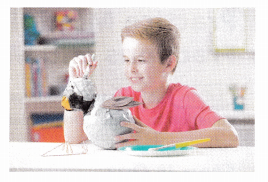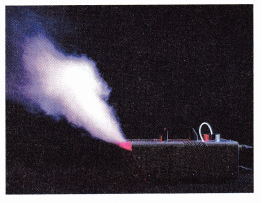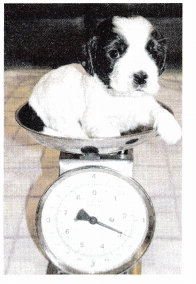We included HMH Into Math Grade 5 Answer Key PDF Module 9 Lesson 3 Practice Multiplication with Fractions and Mixed Numbers to make students experts in learning maths.
HMH Into Math Grade 5 Module 9 Lesson 3 Answer Key Practice Multiplication with Fractions and Mixed Numbers
I Can solve a real world problem by writing a multiplication equation to model the problem.
Step It Out
1. Lara prepares for an upcoming concert. On Saturday, she practiced flute for 2\(\frac{1}{2}\) hours, On Sunday, she practiced \(\frac{1}{2}\) as long as she practiced on Saturday. How long did she practice on Sunday?

A. Write a multiplication equation to model the problem.
________________
Answer:
The equation is 2\(\frac{1}{2}\) × \(\frac{1}{2}\) = \(\frac{5}{4}\).
Explanation:
The multiplication equation to model the problem is 2\(\frac{1}{2}\) × \(\frac{1}{2}\) which is \(\frac{5}{2}\) × \(\frac{1}{2}\) = \(\frac{5}{4}\).
B. Without doing any calculations, how do you know whether she practiced more on Saturday or Sunday?
________________
________________
________________
Answer:
As she practiced \(\frac{1}{2}\) as long on Sunday. So she practiced less on Sunday compared to Saturday.
C. Rewrite your equation from Part A so that the mixed number is renamed as a fraction greater than 1. Then solve the equation.
________________
Answer:
\(\frac{5}{4}\).
Explanation:
The equation is \(\frac{5}{2}\) × \(\frac{1}{2}\) which is \(\frac{5}{4}\).
D. How long did Lara practice on Sunday?
________________
Answer:
\(\frac{5}{4}\) hours.
Explanation:
Lara practiced \(\frac{5}{4}\) hours on sunday.
Turn and Talk Lara models the amount of time she practiced on Friday with the equation \(\frac{4}{3}\) × 2\(\frac{1}{2}\) = r. How does the amount of time she practiced on Friday compare to the amount of time she practiced on Saturday? How do you know?
2. Nick makes a papier mâché black-chinned sparrow for science class. An actual black-chinned sparrow is about 5\(\frac{3}{4}\) inches long. He makes his sparrow 2 times this size. What is the length of his sparrow?

A. Write a multiplication equation to model the problem.
_________________________
Answer:
\(\frac{23}{2}\).
Explanation:
The multiplication equation is 2 × 5\(\frac{3}{4}\) which is 2 × \(\frac{23}{4}\) = \(\frac{23}{2}\).
B. Rewrite your equation from Part A s0 that the whole number and mixed number are renamed as fractions.
_________________________
Answer:
2 × \(\frac{23}{4}\) = \(\frac{23}{2}\).
Explanation:
The equation from part A is 2 × 5\(\frac{3}{4}\) which is 2 × \(\frac{23}{4}\) = \(\frac{23}{2}\).
C. Solve your equation from Part B.
_________________________
Answer:
2 × \(\frac{23}{4}\) = \(\frac{23}{2}\).
Explanation:
The equation from part B is 2 × \(\frac{23}{4}\) = \(\frac{23}{2}\).
D. What is the length of Nick’s black-chinned sparrow?
_________________________
Answer:
Explanation:
The length is 2 × \(\frac{23}{4}\) = \(\frac{23}{2}\) inches.
Turn and Talk How can you use the Distributive Property to find the product for your equation from Part A?
Check Understanding Math Board
Question 1.
The Bucks County Film Festival shows three films. Each film is 1\(\frac{9}{10}\) hours long. How long are all three films? Write a multiplication equation to model the problem.
Answer:
The multiplication equation is \(\frac{57}{10}\).
Explanation:
Given that each film is 1\(\frac{9}{10}\) hours long. So the multiplication equation is 3 × 1\(\frac{9}{10}\) which is 3 × \(\frac{19}{10}\) = \(\frac{57}{10}\).
Find the product.
Question 2.
2 × 3\(\frac{1}{2}\)
Answer:
2 × 3\(\frac{1}{2}\) = 7.
Explanation:
The product of 2 × 3\(\frac{1}{2}\) is 2 × \(\frac{7}{2}\) = 7.
Question 3.
3\(\frac{3}{4}\) × \(\frac{1}{3}\)
Answer:
3\(\frac{3}{4}\) × \(\frac{1}{3}\) = \(\frac{15}{12}\).
Explanation:
The product of 3\(\frac{3}{4}\) × \(\frac{1}{3}\) is \(\frac{15}{4}\) × \(\frac{1}{3}\) = \(\frac{15}{12}\).
On Your Own
Question 4.
Model with Mathematics A fog machine is filled with 1\(\frac{1}{8}\) quarts of fog liquid at the beginning of a music performance. It needs to be refilled with the same amount after 2 hours. How much fog liquid is put into the fog machine? Write a multiplication equation to model the problem.

Answer:
The multiplication equation is 2 × \(\frac{9}{8}\).
Explanation:
Given that a fog machine is filled with 1\(\frac{1}{8}\) quarts of fog liquid at the beginning of music performance. So the multiplication equation is 2 × \(\frac{9}{8}\) which is \(\frac{9}{4}\).
Find the product.
Question 5.
5 × 3\(\frac{1}{3}\)
Answer:
5 × 3\(\frac{1}{3}\) = 16\(\frac{2}{3}\)
Explanation:
The product of 5 × 3\(\frac{1}{3}\) is 5 × \(\frac{10}{3}\) = 16\(\frac{2}{3}\).
Question 6.
2\(\frac{1}{3}\) × \(\frac{1}{4}\)
Answer:
2\(\frac{1}{3}\) × \(\frac{1}{4}\) = \(\frac{7}{12}\).
Explanation:
The product of 2\(\frac{1}{3}\) × \(\frac{1}{4}\) is \(\frac{7}{3}\) × \(\frac{1}{4}\) = \(\frac{7}{12}\).
Question 7.
1\(\frac{3}{4}\) × \(\frac{3}{5}\)
Answer:
1\(\frac{3}{4}\) × \(\frac{3}{5}\) = \(\frac{21}{20}\).
Explanation:
The product of 1\(\frac{3}{4}\) × \(\frac{3}{5}\) is \(\frac{7}{4}\) × \(\frac{3}{5}\) = \(\frac{21}{20}\).
Question 8.
4\(\frac{5}{6}\) × 8
Answer:
4\(\frac{5}{6}\) × 8 = 9\(\frac{2}{3}\).
Explanation:
The product of 4\(\frac{5}{6}\) × 8 is \(\frac{29}{6}\) × 8 = \(\frac{116}{12}\) = 9\(\frac{2}{3}\).
Question 9.
4 × 4\(\frac{1}{8}\)
Answer:
4 × 4\(\frac{1}{8}\) = \(\frac{33}{2}\).
Explanation:
The product of 4 × 4\(\frac{1}{8}\) is 4 × \(\frac{33}{8}\) = \(\frac{33}{2}\).
Question 10.
2\(\frac{1}{4}\) × 4\(\frac{3}{4}\)
Answer:
2\(\frac{1}{4}\) × 4\(\frac{3}{4}\) = \(\frac{171}{16}\).
Explanation:
The product of 2\(\frac{1}{4}\) × 4\(\frac{3}{4}\) is \(\frac{9}{4}\) × \(\frac{19}{4}\) = \(\frac{171}{16}\).
Question 11.
Model with Mathematics Mark is 4\(\frac{1}{3}\) feet tall. His brother Sam is \(\frac{3}{4}\) times as tall as he is.
- Write an equation to model Sam’s height. Then find Sam’s height __________
- Is Sam taller than or shorter than Mark? How do you know? ________
Answer:
Sam is shorter as \(\frac{3}{4}\) is less than 1.
Explanation:
Given that Mark is 4\(\frac{1}{3}\) feet tall and his brother Sam is \(\frac{3}{4}\) times as tall as he is. So the equation will be 4\(\frac{1}{3}\) × \(\frac{1}{3}\) which is \(\frac{13}{3}\) × \(\frac{1}{3}\) = \(\frac{13}{9}\) ft. Sam is shorter as \(\frac{3}{4}\) is less than 1.
Question 12.
Attend to Precision For the next city council election, 1\(\frac{5}{6}\) times as many candidates are running as had run in the last election. In the last election, 24 candidates ran for the city council. Explain how to use the Distributive Property to find the number of candidates who are running in the next election.
Answer:
The number of candidates is 44.
Explanation:
The distributive property to find the number of candidates who are running in the next election is 1\(\frac{5}{6}\) × 24 which is \(\frac{11}{6}\) × 24 = 44.
On Your Own
Question 13.
A puppy weighs 2\(\frac{7}{8}\) pounds. Carla feeds the puppy 3 ounces of food for each pound that the puppy weighs. How many ounces of food does Carla feed the puppy? Write a multiplication equation to model the problem.

Answer:
The multiplication equation is 2\(\frac{7}{8}\) × 3 = \(\frac{69}{8}\) ounces.
Explanation:
Given that a puppy weighs 2\(\frac{7}{8}\) pounds and Carla feeds the puppy 3 ounces of food for each pound that the puppy weighs. So the multiplication equation is 2\(\frac{7}{8}\) × 3 which is \(\frac{23}{8}\) × 3 = \(\frac{69}{8}\) ounces.
Question 14.
Reason Desiree writes songs for her band. Her first song is 3\(\frac{1}{2}\) minutes long. Her second song is 1\(\frac{1}{2}\) times as long as her first song. Her third song is \(\frac{2}{3}\) times as long as her second song.
- How many minutes long are the second and third songs?
- What equations did you use to model the length of each song?
Answer:
The equations are 3\(\frac{1}{2}\) × 1\(\frac{1}{2}\) = \(\frac{21}{4}\) and \(\frac{21}{4}\) × \(\frac{2}{3}\) = \(\frac{7}{2}\).
Explanation:
Given that her first song is 3\(\frac{1}{2}\) minutes long and her second song is 1\(\frac{1}{2}\) times as long as her first song and her third song is \(\frac{2}{3}\) times as long as her second song. So the equation is 3\(\frac{1}{2}\) × 1\(\frac{1}{2}\) which is \(\frac{7}{2}\) × \(\frac{3}{2}\) = \(\frac{21}{4}\). And the other equation is \(\frac{21}{4}\) × \(\frac{2}{3}\) which is \(\frac{7}{2}\) mins.
Question 15.
Brian spends 1\(\frac{3}{4}\) hours carving the parts for a model airplane. He spends 3 times as long assembling and painting the model. How many hours does Brian spend carving, assembling, and painting the model? Explain how you found your answer.
Answer:
7 hours.
Explanation:
Given that Brian spends 1\(\frac{3}{4}\) hours carving the parts for a model airplane and he spends 3 times as long assembling and painting the model. So 3 × 1\(\frac{3}{4}\) which is 3 × \(\frac{7}{4}\) = \(\frac{21}{4}\) hours. And 5\(\frac{1}{4}\) + 1\(\frac{3}{4}\) which is \(\frac{21}{4}\) + \(\frac{7}{4}\) = \(\frac{28}{4}\) = 7 hours.
Question 16.
Use Repeated Reasoning To make a batch of lavender paint, three different types of paint are mixed together: 1\(\frac{1}{2}\) gallons of white, \(\frac{1}{2}\) gallon of red, and 2 gallons of blue. Ronald wants to make 2\(\frac{2}{3}\) batches of lavender paint. How much of each paint color does he need?
Answer:
He needs 4 gallons of white paint, \(\frac{4}{3}\) gallons of red and \(\frac{16}{3}\) gallons of blue.
Explanation:
Given that three different types of paint are mixed together which is 1\(\frac{1}{2}\) gallons of white, \(\frac{1}{2}\) gallon of red, and 2 gallons of blue and Ronald wants to make 2\(\frac{2}{3}\) batches of lavender paint. So white will be 1\(\frac{1}{2}\) × 2\(\frac{2}{3}\) which is \(\frac{3}{2}\) × \(\frac{8}{3}\) = 4 gallons. And for Red it will be 2\(\frac{2}{3}\) × \(\frac{1}{2}\) which is \(\frac{8}{3}\) × \(\frac{1}{2}\) = \(\frac{4}{3}\) gallon. For blue it will be 2\(\frac{2}{3}\) × 2 which is \(\frac{8}{3}\) × 2 = \(\frac{16}{3}\) gallons.